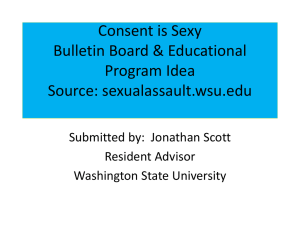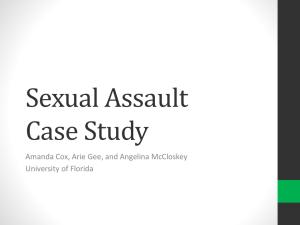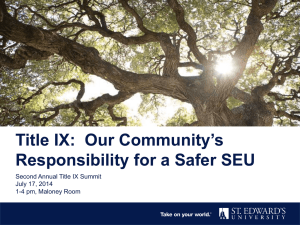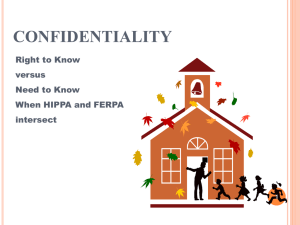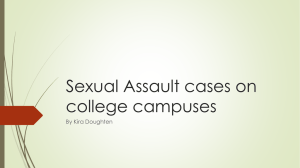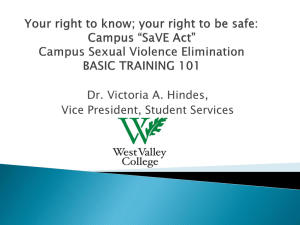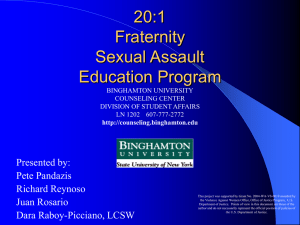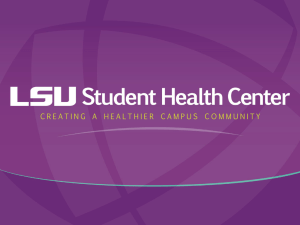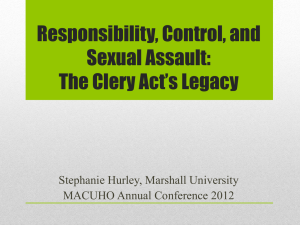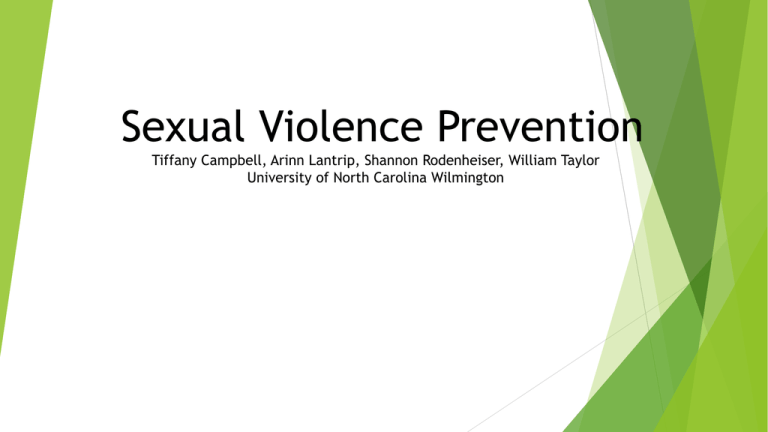
Sexual Violence Prevention
Tiffany Campbell, Arinn Lantrip, Shannon Rodenheiser, William Taylor
University of North Carolina Wilmington
Purpose of this Task Force
Problem: Currently 1 in 5 students are sexually assaulted every year, and
there is a need to help prevent future attacks and assist the survivors. In
addition, there is a need for education to help students understand the
subject at hand.
Goals of this Task Force: Our Task force goal is to provide the rights and
services of the survivor and the accused. In addition we want to create
education programs and campus events so for future prevention and a better
knowledge of the subject. Finally we will have a technological tool that will
help prevent future attacks and create a safer campus environment. These
goals are set to prevent future attacks and a better campus
We will…
Address the rights of both the victims and the accused
Use theory in the development of all prevention and awareness programming
Implement a comprehensive and multifaceted plan to improve awareness and
reduce instances of sexual violence on our campus
Small Group Programming and Education
Consent Pledge
Marketing Techniques
Social Media Engagement
Social Awareness Events
Use of Technology for Prevention (Smartphone App)
Theories used in plan development
Alexander Astin’s Involvement Theory
The Social Change Model of Leadership
Development
We will use these theories in developing our plan
in order to engage students, professors, and the
community, and promote social change through
the implementation of programs.
These
programs include, small group discussions,
and social awareness events
Astin’s Involvement Theory
Astin’s Involvement Theory focuses on the factors that help create and
facilitate development.
Astin believed that the students must be active and involved with the
environment to engage in learning.
This serves as rationale for Student Affairs Professionals and Professors to
create opportunities for students about involvement in and out of the
classroom.
Involvement is defined as the psychological and physical energy that a
student devotes to their experience in a university setting.
Astin’s Five Assumptions
Within the theory Astin had five basic postulates about student involvement.
1.
“Involvement refers to the investment of physical and psychological energy in
various objects”. An object can range from a specific activity to the general
experience in an environment.
2.
“Regardless of the object, involvement occurs along a continuum”. Different
students have different degrees of involvement with an activity.
3.
“Involvement has both quantitative and qualitative features”. Quantitative is the
physical time and energy spent, while qualitative is how the student reviews or
understands the activity.
4.
“The amount of student learning and personal development associated with any
educational program is directly proportional to the quality and quantity of student
involvement in the program”. The more involved you are with an activity, and the
more enjoyable it is, the bigger impact it will have.
5.
“The effectiveness of any educational policy or practice is directly related to the
capacity of that policy or practice to increase student involvement”. Student affairs
needs to create opportunities, so that we can increase the student’s involvement.
The Social Change Model
The Social Change Model was developed for college students who want to
learn to efficiently work with groups to create social change at their
university and in their community.
There are three dimensions that can help invoke Social Change through
interaction, these are: Group Values, Individual Values, and
Community/Societal Values.
Within the dimensions, there are seven values that promote social change.
Collaboration
Common Purpose
Controversy with Civility (Group Values)
Consciousness of self
Congruence
Commitment (Individual Values)
Citizenship (Community/Societal Values)
The Social Change Model
Credit:
http://www.kean.edu/admin/uploads/images
/students/cls/socialchange.png
Rights and Services for the Survivor
Access to university services appropriate to the situation, such as the counseling
center, health center, Law enforcement, housing residence life, and academic
services. In addition survivors will be informed of the community services
available.
Special due process rights, that are afforded by the student judicial board
Self rights of psychological, medical, and legal support. Encouragement to seek
support services Within and outside the university.
Request of change of housing or academic classes for safety reasons.
Strict Confidentiality within the University, where only authorized personnel can
access case details. However the survivor needs to give formal consent.
Incident needs to be reported to a law enforcement agency.
(adapted from UNC-Chapel Hill)
Rights and Services for the Accused
There will be no rights taken from the accused guaranteed by the student
judicial board, Federal or state law, and the United States Constitution.
Right to not self-incriminate
Right of Innocent until proven guilty
All services from the university are available for the accused student unless
they are suspended, including housing and academic changes.
The university will not only refer the student to services on campus but also
refer the accused to services within the community.
(adapted from UNC-Chapel Hill)
Comprehensive Plan Components
Plan designed to improve awareness, generate community support, reduce
instances of sexual violence, and promote social change on the campus and in
the surrounding community.
Small Group Programming and Education
Consent Pledge
Marketing Techniques
Social Media Engagement
Social Awareness Events
Use of Technology for Prevention (Smartphone App)
Small group programming and Workshops
We will host a series of small group presentations titled “Behind the Scenes”. The
series will address various issues surrounding sexual violence. These small group
opportunities will be used to create an environment that encourages discussion.
Assist students in building a skill set that will prepare them to face and prevent sexual
violence in the future
Individual programs can be specialized and applied to niche groups (i.e. fraternities,
sororities & other student organizations, residence hall communities, training for student
staffs)
Makes information available in a fun and interactive way
Presentation topics will include:
Personal Safety
Consent
Bystander behavior
Responsible encounters after consuming alcohol
Behind the Scenes: Personal Safety
A professional self defense instructor will teach basic personal safety tactics
to participants, and provide a hands-on experiences for the students
The program will also include mention of available campus resources in case
students find themselves in an unsafe sitation and need help
Campus Police
Blue light/call box programs
Escorts and transportation options available during evening hours
Behind the Scenes: Consent is Sexy
Watch the video C is for Consent
http://www.youtube.com/watch?v=Fm-5cOoHGtM
Discuss the video in small groups
Students will have an opportunity to write down their own definition of
consent and share it with the group
Students will engage in a Myth/Fact Game using clickers about sexual assault
and consent
Behind the Scenes: Dating Safety
http://www.youtube.com/watch?v=zGGIf_4wqSQ
Role plays will be done to provide examples of dating safely and unsafely.
(Potentially utilizing the theater department or a student performance group
for skit examples)
Students will engage in discussion about healthy verses unhealthy
relationships and dating scenarios
Create a TOP 5 must have for a healthy relationship
Present scenarios for students to address how they would handle an unsafe or
unhealthy situation
Tips on what to do if you find yourself in an unhealthy relationship, and
resources available to students
Behind the Scenes: Helping Hands
Class will address and educate on bystander behavior
What to do when you see something that doesn’t seem right happening
between friends or romantic couples
Ideas for distracting people when a situation becomes uncomfortable or gets
out of hand
Behind the Scenes: Beer Goggles
This class will provide students with an opportunity to use Beer Googles while
completing simple tasks
Allow students to reflect on how difficult it was to complete task and then
discuss how it might apply to sexual situations
Pledge for Consent
Each small group workshop will provide an opportunity for students to sign
the “Pledge for Consent”
By signing the pledge, students will agree to always seek consent, and
recognize boundaries when a partner does not give consent
The pledge will clearly define what it means to get and give consent and what
non-consent means
Students will pledge to take a stand against sexual violence and to be
proactive in prevention in their communities
Marketing Campaign
A marketing plan will be developed to create a consistent presence of these
important messages on campus.
Employ strong, clever, repetitive statement language and a consistent, eye
catching format to promote awareness
“No, is a full sentence. Get consent.”
“Ask the question. Hear the answer. Get consent.”
“Consent is for everyone. Get consent.”
“Consent is sexy. Get consent.”
Use high concentrations of visual marketing (posters, print ads in student
newspapers and magazines, slide ads on campus TV channels, etc.) to
increase visibility for the cause
Visuals should be highly concentrated in student-centric areas like the Student
Union, Recreation Center, dining halls, lounges in academic buildings, etc.
Potentially reach out to student friendly businesses near campus for posting
(Bowling alleys, coffee houses, concert venues, boutiques, ice cream shops and
potentially even bars/clubs frequented by students)
Make this kind of language (and the idea of consent) something students are used
to seeing day to day
“NO.”
Consent is for everyone.
Get consent.
…is a full sentence. Get consent.
Ask the question.
Hear the answer.
Get consent.
Consent is SEXY.
Get consent.
Social Media Engagement
Continue the conversation from the simple & static print marketing via social media.
Employ the same color schemes and language from print marketing materials in social
media accounts to keep a consistent and recognizable message
Use same strong statements from print marketing
Use pieces of statements to create hashtags. Encourage students to use them to
share ways they promote consent and safe sexual encounters
Hashtag use must be organized and intentional so as not to water down its effectiveness
Student leaders and peer educators will be needed to introduce and popularize these
hashtags to get initial visibility.
#igetconsent – used to talk candidly about appropriate approaches to getting consent
#consentisforeveryone –used to promote the idea that consent is not exclusively either genders’
responsibility
#consentissexy- used to promote the idea that healthy sexual encounters in which both partners
are consenting are more enjoyable for both parties
Focus primarily on positive change and prevention via social media rather than
rather than sexual violence itself. Victims may find the violence too painful to
discuss, and others may feel unequipped to understand.
Social media will be most effective when many people can engage and contribute,
as it will improve awareness and promote positive culture changes.
Social Awareness Events
We will program several Sexual Assault Awareness events to provide
opportunities to educate large groups of students about sexual violence issues
and how to prevent them.
The events will take several forms and have varying focuses:
Survivors and the Healing Process- “Speak Out events”, allow survivors to tell their story and
give them the opportunity educate students at the event.
Fundraising- some events may have a monetary component to fundraise for non profit groups
that support victims and prevention
Education- events such as speakers, film screenings, and theatrical performances that raise
awareness and educate the community. These events can touch a large number of students
across many campus demographics at once.
Creating solidarity in the community- Events that bring the community together for education
and a show of support for preventing sexual violence. These events also reinforce the idea
that prevention is everyone’s responsibility.
Characteristics of Impactful Events
Comprehensiveness- By showing all aspects and relevant materials. Including
Bystander and enabling issues.
Intensiveness- Active involvement and sustained over time.
Relevance- Tailored to the people attending, and the emphasis on solving the
problem.
Positive Message- How to prevent the issue, and the focus of activism.
Potential Events
Social Awareness play or cinema
Major Speaker talking about Prevention of Sexual Assault
A “Speak Out” event and Candlelight Vigil
Poetry Slam
A Consent 5k Run- where information and important information is
shown throughout the run
Art Exhibits – Where survivors can express their feeling through art
and photography
A “Rock against Rape” concert or battle of the bands event
“Take Back the Night” march and rally that shows support for sexual
assault prevention and brings the community together
Smart Phone Application
For some victims of sexual assault, verbalizing an attack can be one of the
hardest things to do. By developing a smart phone application, we will
provide a private and discreet venue where victims can send a text account of
the attack to the rape crisis center and/or police.
The app will be called “1Click”
Designed to be inconspicuous on a smart phone screen, but also reiterate the idea
that the functions and resources within the app are just one click away.
Functions of the Application
Store emergency numbers such as local rape crisis centers, campus police, and
911, making important resources just one click away
Users of 1Click will have access to a message board for their community showing
suspicious activity and have registered names for convicted sex offenders
1Click would provide students with a way to communicate with friends (who also
have the app)
App users can communicate to get help removing themselves from uncomfortable or
potentially unsafe situations. Within the app they can click a friends face and send them
a pre-scripted text:
Text me, I need help getting away from this girl/guy at the club
Call me and say you need to talk
I am intoxicated please come pick me up and then NAME would send the GPS location of where
the person is.
References
Ask first [gif]. (2012). The new school Retrieved from
http://www.newschool.edu/uploadedImages/Student_Services/Health/Content/i
mages/askfirst.gif?n=9179 on February 19, 2014
Astin, A. W. (1999). Student involvement: A developmental theory for higher
education. Journal of College Student Development, 40(5), 518-529. Retrieved
from http://kvccdocs.com/KVCC/2013-Spring/FY125-OLA/content/L17/Student%20Involvement%20Article.pdf
Cheatham, Angie (2011, July 27). Crossway: Myths and facts about sexual assault.
Retrieved from http://www.crossway.org/blog/2011/07/myths-and-facts-aboutsexual-assault/ on February 17, 2014
Cilente, K. (2009). An overview of the social change model of leadership
development. In Leadership for a better world: Understanding the social change
model of leadership development (pp. 43-76). Retrieved from
http://www.neiu.edu/~lead/downloads/leadforabetterworld.pdf
[Dating safely sign]. Retrieved from
http://www.datingallhours.com/Images/freedating-sites
on February 19, 2014
Domitrz, Mike (2013). Date safe project. Retrieved from www.datesafeproject.org,
on February16, 2014.
[Evan-Amos] (2010, October 31).
http://commons.wikimedia.org/wiki/File:Handcuffs-Black.jpg
Event sugesstions. (2013). Retrieved from Sexual Assault Awareness Month website:
http://www.nsvrc.org/saam/resources/events
dating-safety.png
References (continued)
Green Dot (2013). Saint Louis University [gif]. Retrieved from https://www.slu.edu/office-of
student-responsibility-and-community-standards/green-dot , on February 19, 2014
[Julia]. (2013, April 19). Movie clapper clip art Retrieved from http://www.clker.com/clipartmovieclapper-4.html on February 19, 2014
Kilmartin, C. (2001). Sexual assault in context: Teaching college men about gender.Retrieved
from http://www.alanberkowitz.com/articles/critical_elements.pdf
Men can stop rape (2011). The where do you stand? Campaign [posters] Retrieved from
http://www.mencanstoprape.org/Strength-Media-Portfolio/preview-of-new-bystander
intervention-campaign.html Retrieved on February 19, 2014
[NWDA Sullivan] . (2014, April 5). Consent: The difference between sex & rape [Video file].
Retrieved from http://www.youtube.com/watch?v=zGGIf_4wqSQ on February 18, 2014
Safety-clip-art-7 [gif]. (2013, March 27). Retrieved from 2014.
http://bestclipartblog.com/29-safety-clipart.html/safety-clip-art-7, on February 19, 2014
Sexual Assault Response Plan - Dean of Students - The University of North Carolina-Chapel
Hill.(2014). website:
http://deanofstudents.unc.edu/sites/deanofstudents.unc.edu/files/SexualAssaultResponsePl
an_0.pdf
The University of Arizona C.A.T.S. life skills program in partnership with the NCAA (2010).
Myths and facts: Sexual assault [PDF document]. Retrieved from
http://www.stepupprogram.org/docs/handouts/STEPUP_SexualAssault_Myths_and_%2
Facts.pdf, on February 17, 2014
[vhenderson14]. (2011, March 28). Myths vs fact – sexual assault awareness [Video file].
Retrieved from http://www.youtube.com/watch?v=4MbnlljR5Qo on February 18, 2014


